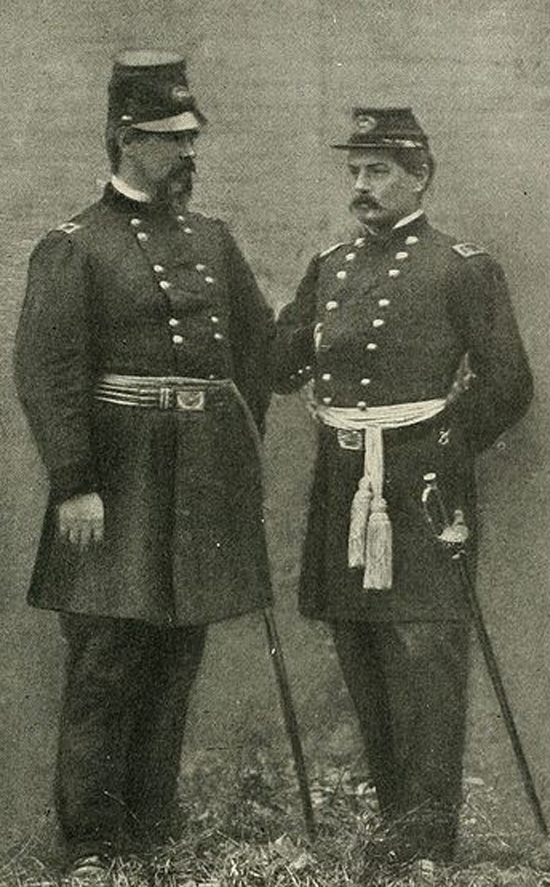While it is widely accepted that the sun/pith helmet most certainly originated in India, it remains a point of conjecture whether the sun helmet traveled not to Europe but to America, where it found its way to the first battlefields outside of the Indian subcontinent during the American Civil War.
Some sources suggest that the 4th New Hampshire Infantry may have worn a “pith helmet” or sun helmet to protect the soldiers from the intense southern sun during its campaigns in Florida, but what remains much more of a mystery is exactly what Brigadier General Irvin McDowell (above left with General George McClellan) may have worn at the Battle of Bull Run – the first major engagement of the war between the states.
In the book Uniforms of the Civil War by Francis Alfred Lord it is noted, “Irvin McDowell, the hapless commander at both battles of Bull Run, wore a pith hat or helmet to protect him from the rays of the sun. In August 1862, this hat, which ‘looked like an inverted washbowl,’ aroused much unfavorable comment from among his troops.”
Another book, The Civil War: A Narrative: Volume 1: Fort Sumter to Perryville by Shelby Foote adds to the mystery, with the author stating, “’Slogging through the drizzle of rain, they saw him sitting his horse by the pike, identifiable in the murk because of the outlandish silhouette of his canvas helmet One Massachusettes private nudged another pointing, and said darkly: ‘How guilty he looks, with that basket on his head!”‘
Both passages do evoke the image of a sun/pith helmet.
Yet another account, from the book Ten Years in the Saddle: The Memoir of William Woods Averell further adds:
“The scene presented on the gran portico of Arlington House on that day when McDowell came forth arrayed for the field in the uniform of a Brigadier General and otherwise distinguished by his white helmet with the bright lance-head on top, and followed by a well appointed staff, was impressive.”
McDowell is largely forgotten today except by Civil War buffs, and when remembered is best known for his defeat in the First Battle of Bull Run. Because he was in essence the losing general of the battle little is written about him and other than those contemporary passages nothing is noted of what helmet or hat he may have worn.
This author previously had understood that McDowell had been well traveled, but there is conflicting evidence as to whether he ever actually did travel to India.
Between 1848 and 1861 the official record suggests that he primarily served as a staff officer to higher-ranking military leaders, and developed experience in logistics and supply. He served as aide-de-camp to General John E. Wood during the Mexican-American War (1846-1848), and was promoted to Major on May 31, 1856 – around the time of Indian Mutiny.
While an officer in the United States Army prior to the Civil War he did a great deal of travel. A question now remains whether those travels took him to India. If this was the case, then the mystery of the sun helmet can be explained that he encountered the pattern during this travels.
It was of course common for military officers to take overseas trips, and the man who took charge of the Union Army after McDowell’s debacle at Bull Run, George Brinton McClellan, did journey to Europe to study military tactics being used in the Crimean War (1853-56). It is also established that American officers did visit India during the years of the Mutiny, for which time it seems that McDowell was apparently out of the country.
However, if McDowell was not present in India than the mystery of his choice of headgear at Bull Run is one that only remains a mystery. One that might never truly be resolved.
Peter Suciu


My great-great-grandfather fought in the Civil War as a private in Company I of the 1st New Jersey Cavalry. I have a letter he wrote to his wife on September 7, 1862, which contains the following comment regarding General McDowell’s headgear: “But on the Second days fight McDowell Sold us all and it turned out Bull Run Second, the first thing the country ought to do is to hang him, he does not go about So Stylish for nothing he is a fine noble looking traiter I can tell you, he wears a very Strange Looking cap the crown and Shield is all one and comes out over his face quite a ways, the rebels Say they know him just as quick as they See that cap of his”
In the context of the 4th NH, you’re referencing the Whipple Hat. It was relatively common for early war New England units.
The US Sharpshooters also wore them for at least part of their service.